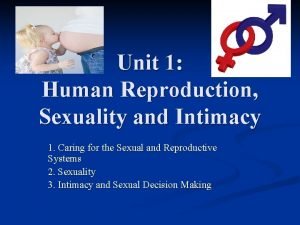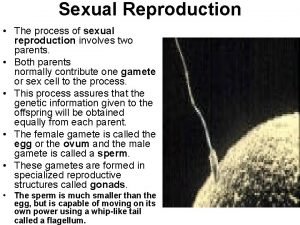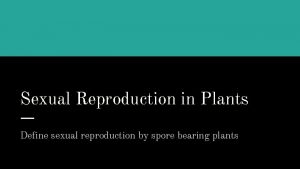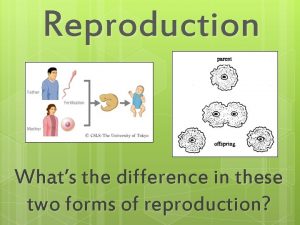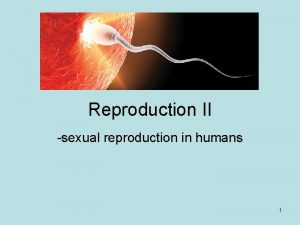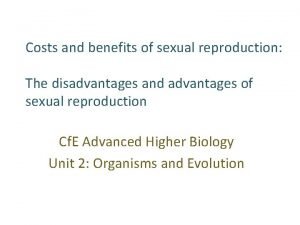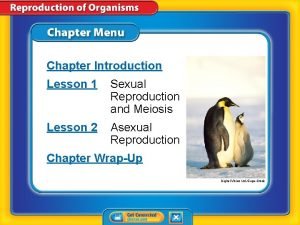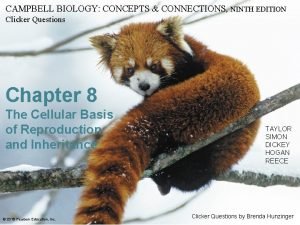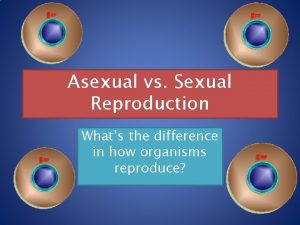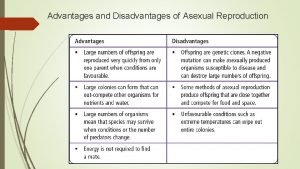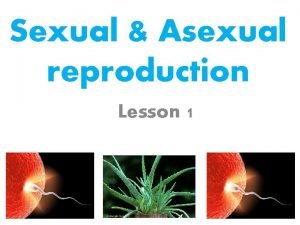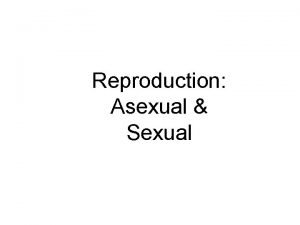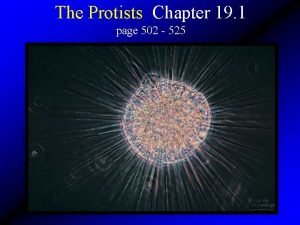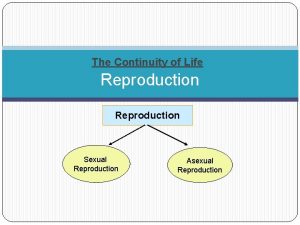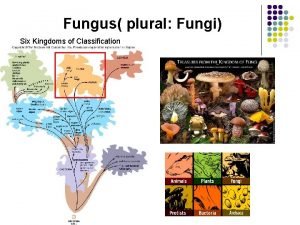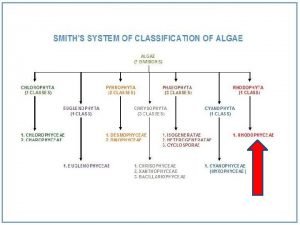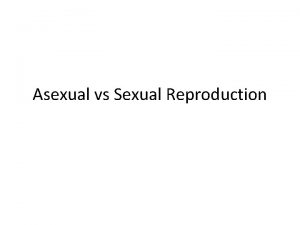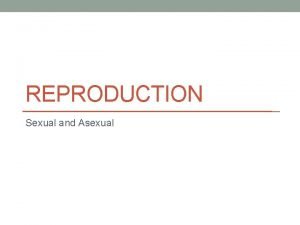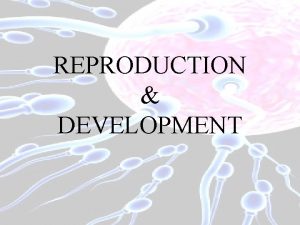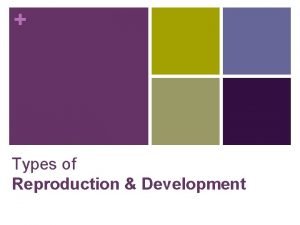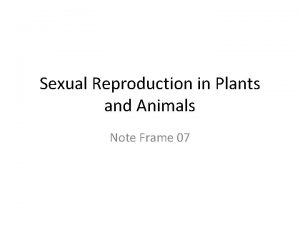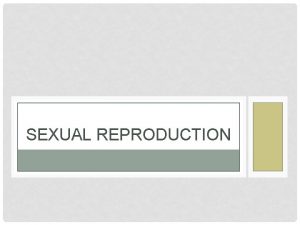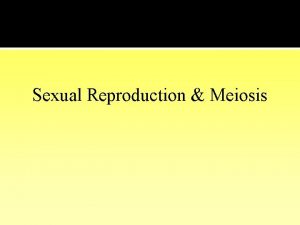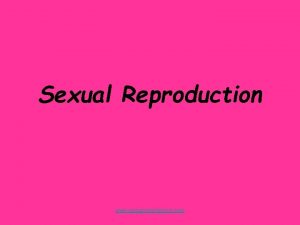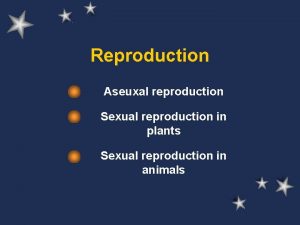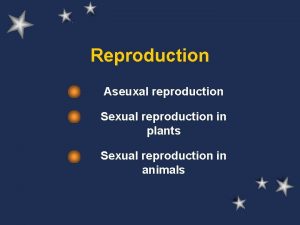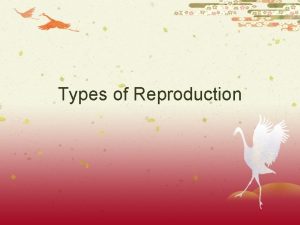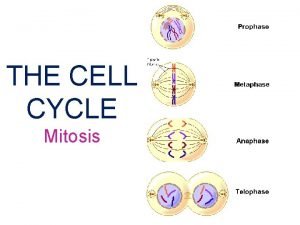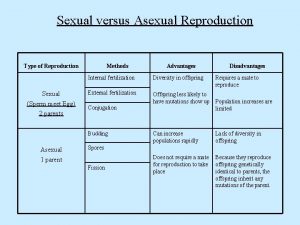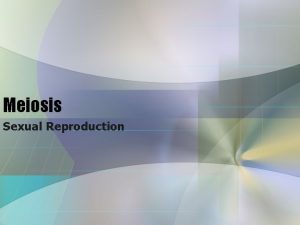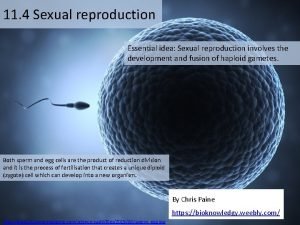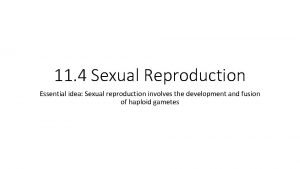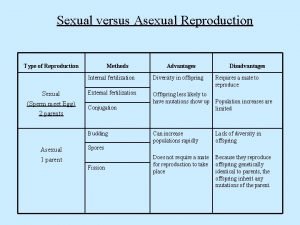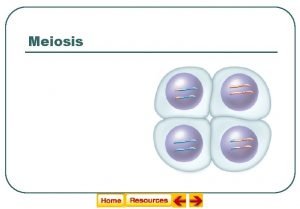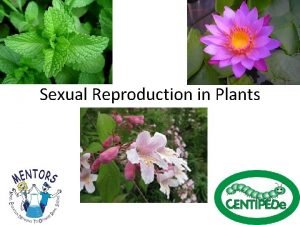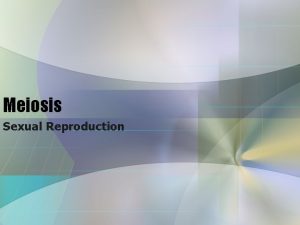Types of Reproduction Development Sexual Reproduction n The


































- Slides: 34

+ Types of Reproduction & Development

+ Sexual Reproduction n The fusion of reproductive cells from two separate individuals to form a new offspring. n Offspring produced by sexual reproduction inherit some of their genetic information from each parent. Parent Offspring

+ Internal vs. External Fertilization n Internal Fertilization occurs inside the body.

+ Internal vs. External Fertilization n External Fertilization occurs outside the body.

+ Internal vs. External Fertilization REMINDER!!! Sperm + Egg Zygote = “the fertilized egg”

+ Internal vs. External Development n Internal Development occurs inside the body of the mother.

+ Internal vs. External Development n External Development occurs outside the body of the mother.

+ Human Development n Differentiation: Point in human development where certain genes turn on and others turn off. n This causes different cells to develop special functions (Specialization).


+ TWINS!!! n Fraternal Twins – two eggs released during ovulation and both are fertilized by different sperm producing two different embryos. n Identical Twins – one egg is released and is fertilized by one sperm, but the zygote splits in half producing two identical embryos.

+ Asexual Reproduction n The production of two genetically identical offspring from a single parent n Single-celled organisms can ONLY reproduce asexually n No sperm or egg cell involved Parent Offspring

+ Types of Asexual Reproduction n Binary Fission (amoeba)

+ Types of Asexual Reproduction n Budding (Hydra)

+ Types of Asexual Reproduction n Regeneration

+ Cell Division Mitosis & Meiosis

+ Cell Division Vocabulary Words n DNA – carries the genetic information of the cell n Nucleus – stores DNA n Chromosomes – threadlike structure of condensed DNA that contains an individual’s genes n Homologous Pair – a pair of matching chromosomes, one inherited from each parent n 23 homologous pairs in humans = 46 total chromosomes

+ Homologous Chromosomes

+ Cell Division Vocabulary Words n Diploid – number of chromosomes in all somatic cells (2 n) n For humans, diploid is 46 n Haploid n – number of chromosomes in all gametes (n) For humans, haploid is 23 n Parent Cell- what you start with n Daughter Cell – the product n Somatic Cell – a body cell. Any cell other than egg/sperm n Gamete – a sex cell (egg or sperm)

+ Mitosis Making exact copies of cells (Cell Division)

+ Mitosis n. Purpose: growth and repair n. One diploid parent cell produces two identical diploid daughter cells. n. Mitosis = Asexual Reproduction of cells

+ Meiosis Making sex cells (sperm and egg)

+ Meiosis n. Purpose: making gametes n. One diploid parent cell produces four different haploid daughter cells. n Each daughter cell is unique and different from the parent cell AND the other daughter cells.

+ Meiosis n. Also called “gametogenesis” n. Males = Make 4 Sperm Cells n. Females = Make 1 Egg Cell & 3 Polar Bodies

+ Crossing Over n During Meiosis, some information on the chromosomes may switch between homologous pairs. n This results in genetic variation.


+ Human Development

+ Interphase DNA duplication occurs to prepare for cell division.

+ Prophase DNA forms into chromosomes and centrioles move to opposite ends of nucleus.

+ Metaphase Chromosomes line up in center of cell and spindle fibers from centrioles attach.

+ Anaphase Chromosomes begin moving towards opposite ends of nucleus (pulled by centrioles).

+ Telophase Chromosomes reach opposite sides and cleavage occurs, forming two identical daughter cells.

Mitosis +

Mitosis +

 The disadvantages of sexual reproduction
The disadvantages of sexual reproduction Asexualk
Asexualk Venn diagram of sexual and asexual reproduction in animals
Venn diagram of sexual and asexual reproduction in animals A sexual reproduction in humans
A sexual reproduction in humans Chapter 20 sexual reproduction in animals
Chapter 20 sexual reproduction in animals гаструла бластула
гаструла бластула Define sexual reproduction
Define sexual reproduction Section 1 meiosis
Section 1 meiosis Whats reproduction
Whats reproduction Reproduction human
Reproduction human Chapter 10 sexual reproduction and genetics
Chapter 10 sexual reproduction and genetics Parthenogenesis asexual reproduction
Parthenogenesis asexual reproduction Reproduction of organisms
Reproduction of organisms Sexual reproduction and genetics section 1 meiosis
Sexual reproduction and genetics section 1 meiosis Mitosis sexual reproduction
Mitosis sexual reproduction Campbell biology concept check answers
Campbell biology concept check answers Whats asexual reproduction
Whats asexual reproduction Sexual reproduction example
Sexual reproduction example Disadvantages of sexual reproduction
Disadvantages of sexual reproduction Two types of reproduction
Two types of reproduction Significance of sexual reproduction
Significance of sexual reproduction Advantages of genetic diversity
Advantages of genetic diversity Venn diagram of meiosis and mitosis
Venn diagram of meiosis and mitosis Asexual vs sexual reproduction venn diagram
Asexual vs sexual reproduction venn diagram Chapter 19 protists study guide answers
Chapter 19 protists study guide answers Sexual or asexual reproduction
Sexual or asexual reproduction Fungi or fungus plural
Fungi or fungus plural Division rhodophyta
Division rhodophyta Chapter 10 sexual reproduction and genetics
Chapter 10 sexual reproduction and genetics Sexual or asexual reproduction
Sexual or asexual reproduction Asexual or sexual reproduction
Asexual or sexual reproduction Asexual or sexual reproduction
Asexual or sexual reproduction Sexual reproduction
Sexual reproduction Sexual reproduction
Sexual reproduction Where does cactus store water
Where does cactus store water



